固相萃取和分散固相凈化-串聯質譜測定茶鮮葉和干茶中的農藥殘留
楊潔,周利,余煥,孫荷芝,王新茹,張新忠,楊梅,陳宗懋,羅逢健
固相萃取和分散固相凈化-串聯質譜測定茶鮮葉和干茶中的農藥殘留
楊潔1,2,周利1*,余煥1,2,孫荷芝1,王新茹1,張新忠1,楊梅1,陳宗懋1,羅逢健1*
1. 中國農業科學院茶葉研究所農產品質量安全研究中心,浙江 杭州 310008;2. 中國農業科學院研究生院,北京 100081
建立了茶鮮葉和干茶中9種農藥的殘留分析方法。樣品中的殘留農藥經乙腈提取,Florisil/GCB固相萃取柱和PSA/GCB分散固相聯合凈化,超高效液相色譜串聯質譜(UPLC-MS/MS)和氣相色譜質譜聯用(GC-MS)測定。在0.005~1.000?mg·kg-1的添加水平下,目標農藥在鮮葉和干茶中的平均回收率在70.3%~103.9%,相對標準偏差(RSD)<20.0%。在0.005~2.000?mg·kg-1濃度范圍,目標農藥在鮮葉和干茶基質中的線性關系良好,>0.995?4。定量限(LOQ)為0.005?mg·kg-1。實際樣品檢測結果表明,該方法靈敏度高,重現性好,能夠滿足農藥多殘留檢測的要求。
農藥多殘留;超高效液相色譜串聯質譜;氣相色譜質譜聯用;茶;固相萃取;分散固相凈化
茶樹生長在濕熱的環境中,病蟲草害較易發生,化學防治仍是其防治的方法之一[1]。在茶樹生長期內,通常需要施用化學農藥以保障茶葉產量和質量。由于農藥抗性和農藥產業的發展,茶園常用農藥也需更新換代[2]。研究表明,魚藤酮[3]、甲氧蟲酰肼[4-5]、嘧菌酯[6]等對茶園危害嚴重的茶尺蠖、假眼小綠葉蟬、斑點病等病蟲害具有較好的防治效果,具有在茶園登記應用的潛力。聯苯菊酯早在1988年就在我國登記使用,對茶葉中的多種害蟲有較好的防治效果[7]。茚蟲威、蟲螨腈、苯醚甲環唑、氟啶蟲酰胺、吡唑醚菌酯是近年茶園中登記農藥品種。
上述農藥在茶葉中的前處理方法包括分散固相萃取法(dSPE,Dispersive solid-phase extraction)[8-12]、固相萃取法(SPE,Solid-phase extraction)[13-15]、加速溶劑萃取法[16]和凝膠滲透色譜法[17]等。其中常用的SPE柱有TPT柱[18]、Carb-NH2柱[19-20]、PSA柱[21-22]和Florisil柱[13,23]等,通常使用物質的回收率和對基質的凈化效果來判定SPE柱的適用性[24]。
我國茶葉農藥多殘留分析方法國家標準GB/T 23204—2008《茶葉中519種農藥及相關化學品殘留量的測定氣相色譜-質譜法》和GB/T 23200.13—2016《茶葉中448種農藥及相關化學品殘留量的測定液相色譜-質譜法》中,均采用乙腈提取、TPT固相萃取柱凈化、質譜儀測定茶葉中的農藥多殘留,但是上述兩個國家標準中均無茶葉中氟啶蟲酰胺分析方法。茶葉中富含的茶多酚、生物堿、色素和糖[25]等內含物質易與目標農藥形成共流出物,對目標化合物的分析造成干擾[26],因此茶葉中農藥殘留分析對樣品前處理要求較高。本試驗通過比較TPT柱、Carb-NH2柱、Florisil+GCB混合柱和Florisil+GCB混合柱-分散固相萃取4種方法對茶鮮葉和干茶基質的回收率、凈化效果和試驗時間成本的差異,建立了茶鮮葉和干茶中9種農藥的Florisil/GCB固相萃取柱結合PSA/GCB分散固相凈化的樣品前處理方法,并應用于實際樣品測定。
1 材料與方法
1.1 儀器與試劑
Varian 450GC-300MS氣相色譜-質譜聯用儀(美國Varian公司);Waters ACQUITY UPLC H-Class超高效液相色譜-Waters Vevo TQ-SMicro三重四極桿串聯質譜儀,配有MassLynx 4.1處理軟件(美國Waters公司);3K-15冷凍離心機(德國Sigma公司);Vortex Genie 2型渦旋振蕩器(美國Scientific Industries);R-210旋轉蒸發儀(德國IKA公司);玻璃柱管(200?mm×10?mm,杭州常盛科教器具廠);0.22?μm Filter Unit濾膜(天津博納艾杰爾科技有限公司)。
農藥標準物質(德國CNW Technologies Gmb H公司,純度>99.0%)。乙腈、正己烷、丙酮(色譜純,德國默克公司);甲酸(色譜純,上海安譜實驗科技股份有限公司);無水硫酸鎂、無水硫酸鈉、無水乙酸鈉(分析純,上海凌峰化學試劑有限公司);無水氯化鈉(分析純,廣東光華科技股份有限公司);超純水(杭州娃哈哈有限公司);GCB(120~400目)、PSA(40~60?μm)、Cleanert TPT凈化柱(1?g/6?mL)、Cleanert PestiCarb-NH2凈化柱(1?g/6?mL)(天津博納艾杰爾科技有限公司);Florisil吸附劑(60~100目,溫州市化學用料廠)。
1.2 標準溶液配制
分別稱取9種化合物標準品各0.01?g,用乙腈(色譜純)溶解并定容至10?mL,分別配制成1?000?mg·L-1標準儲備溶液,–20℃保存。將上述標準儲備液用乙腈逐級稀釋成2.00、1.00、0.50、0.20、0.05、0.005?mg·L-1系列混合標準工作溶液。
1.3 樣品的提取與凈化
準確稱取2.0?g粉碎后的鮮葉或干茶樣品(精確至0.01?g)于50?mL離心管中(干茶中加入1?mL水混勻靜置10?min),加入20?mL乙腈,渦旋震蕩1?min,靜置15?min,再加入1?g無水氯化鈉和1?g無水硫酸鎂,渦旋震蕩1?min,8?000?r·min-1離心5?min后,取10?mL上清液于雞心瓶中,旋轉蒸發至近干,待凈化。4種凈化方式如下:
1.3.1 TPT柱凈化
用10?mL乙腈-苯(乙腈∶苯=3∶1)預淋洗TPT柱,25?mL乙腈-苯(乙腈∶苯=3∶1)分5次潤洗雞心瓶后上柱,接收流出液,旋轉蒸發濃縮至近干后吹干,加入1?mL乙腈溶解殘渣,過0.22?μm尼龍微孔濾膜后轉移至進樣小瓶,待進樣分析。
1.3.2 Carb-NH2柱凈化
用10?mL乙腈-苯(乙腈∶苯=3∶1)預淋洗Carb-NH2凈化柱,25?mL乙腈-苯(乙腈∶苯=3∶1)分5次潤洗雞心瓶后上柱,接收流出液,旋轉蒸發濃縮至近干后吹干,加入1?mL乙腈溶解殘渣,過0.22?μm尼龍微孔濾膜后轉移至進樣小瓶,待進樣分析。
1.3.3 Florisil+GCB混合柱凈化
用5?mL丙酮-正己烷(丙酮∶正己烷=1∶1)預淋洗自制的Florisil+GCB混合柱,用15?mL丙酮-正己烷(丙酮∶正己烷=1∶1)分3次潤洗雞心瓶后上柱,接收流出液,旋轉蒸發濃縮至近干后吹干,用1?mL乙腈定容,過0.22?μm尼龍微孔濾膜后轉移至進樣小瓶,待進樣分析。
自制Florisil+GCB混合柱:在玻璃層析柱中,從下至上依次裝入脫脂棉,1?g無水硫酸鈉,2.05?g混勻的Florisil和GCB(質量比為2∶0.05),1?g無水硫酸鈉。Florisil吸附劑使用前在650℃下烘5?h,放入干燥器冷卻,使用時,按照超純水∶吸附劑=7∶100的比例加入超純水混勻靜置4?h后使用。
1.3.4 Florisil+GCB混合柱和dSPE聯合凈化
將1.3.3章節中定容后的乙腈溶液轉移到盛裝有30?mg PSA和30?mg GCB的2?mL離心管中,渦旋震蕩30?s,12?000?r·min-1離心1?min,過0.22?μm尼龍微孔濾膜后轉移至進樣小瓶,待進樣分析。
1.4 添加回收率試驗
在茶鮮葉和空白樣品中,分別添加標準混合溶液,制備添加水平為0.005、0.05、1?mg·kg-1的茶鮮葉添加樣品,和添加水平為0.005、0.05、0.5?mg·kg-1的成茶添加樣品,每個添加水平5個重復,渦旋混勻后過夜放置,按照1.3.4章節進行提取凈化。
1.5 儀器條件
1.5.1 超高效液相色譜-串聯質譜條件
液相色譜條件:色譜柱ACQUITY UPLCBEH C18(2.1?mm×100?mm×1.7?μm);流動相A為乙腈(含1‰甲酸),流動相B為超純水,進樣量5?μL,流速0.25?mL·min-1,柱溫40℃,流動相洗脫程序:0~0.5?min(A 5%~30%),0.5~3?min(A:30%~70%),3~5?min(A:70%~85%),5~6?min(A:85%~99%),7~8?min(A:99%~5%),8~9?min(A:5%)。離子源模式ESI+,多反應監測MRM模式;離子源溫度150℃;脫溶劑氣溫度350℃;毛細管電壓3.5?kV;脫溶劑氣N2;碰撞氣Ar;目標化合物質譜參數見表1。
1.5.2 氣相色譜-串聯質譜條件
氣相色譜條件:色譜柱VF-5ms(30?m×0.25?mm×0.25?μm,美國安捷倫公司);升溫程序80℃保持1?min,以20℃·min-1的速率升至200℃,以6℃·min-1的速率升至266℃,以1.5℃·min-1的速率升至280℃,保持5?min。
質譜條件:離子源溫度230℃;傳輸線溫度280℃;進樣口溫度250℃;載氣為高純氦氣,純度≥99.999%;離子化方式:EI;監測模式為選擇離子監測SIM,目標化合物質譜參數見表2。
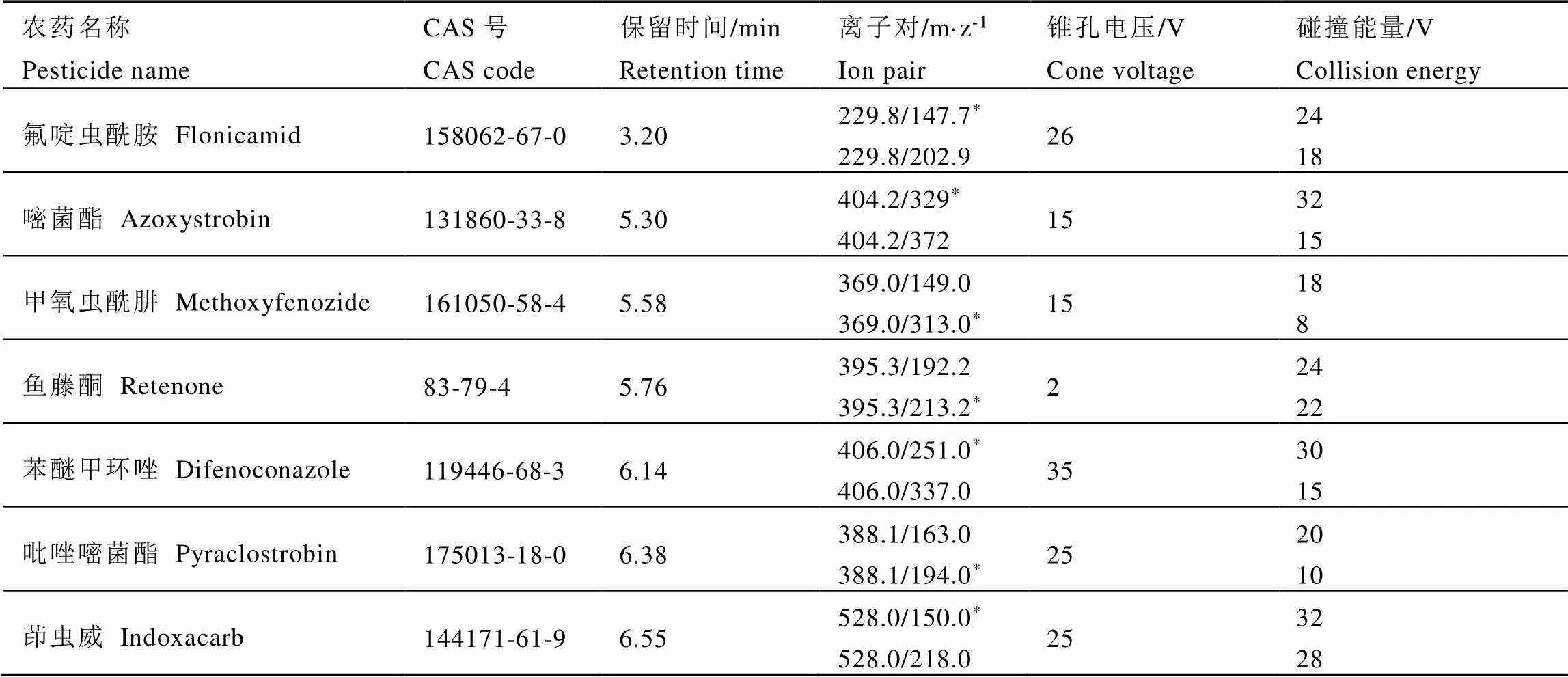
表1 農藥測定的ESI+-MS/MS條件
注:*:定量離子
Note: *: Quantification ions

表2 農藥測定的EI-MS條件
1.5.3 定性定量方法
在與基質匹配標準溶液相一致的保留時間下,所選擇的所有離子或離子對的豐度比與基質匹配標準溶液樣品的離子豐度比相一致(相對豐度>50%,允許±20%偏差;相對豐度>20%~50%,允許±25%偏差;相對豐度>10%~20%,允許±30%偏差;相對豐度≤10%,允許±50%偏差)[27],則可判斷樣品中存在該目標化合物。目標化合物的定量采用外標法,定量用溶液采用基質匹配標準溶液。
2 結果與分析
2.1 樣品前處理條件優化
對比了1.3.1章節中TPT柱、1.3.2章節中Carb-NH2柱和1.3.3章節中Florisil+GCB混合柱3種凈化方式對目標化合物的回收率和基質效應(ME,采用單點校正方式,=(A-A)÷A×100%,其中A表示基質匹配標準溶液的響應,A表示溶劑標準溶液的響應)。由表3可知,采用Carb-NH2柱凈化后物質的回收率在56.7%~84.1%,而采用TPT和Florisil+GCB兩種方法凈化后的回收率在71.2%~94.9%,RSD為1.2%~14.0%,滿足農藥殘留測定要求[28]。TPT柱凈化后的基質效應稍大于Florisil+GCB的基質效應。
但是Florisil+GCB混合柱凈化后的定容溶液呈墨綠色,易對質譜造成污染。采用1.3.4章節方法,即加入GCB和PSA分散固相吸附劑再次凈化后,溶液呈淺黃色,是由于GCB和PSA可去除基質中的有機酸、糖類和極性色素等[29-31]。經1.3.4章節處理后,目標物質的回收率在70.6%~108.4%,RSD<20%。
比較體積比為9∶1、8∶2、7∶3、1∶1的正己烷-丙酮洗脫溶液對Florisil+GCB混合柱凈化后回收率的影響(圖1),結果表明,隨著丙酮比例的增加,目標化合物回收率增加。在正己烷∶丙酮=1∶1混合溶液洗脫時,9種農藥的添加回收率增加到73.9%~107.3%。洗脫溶劑體積對回收率的影響如圖2所示,隨著洗脫溶劑體積增加,目標化合物回收率增加,當洗脫溶液體積增加到15?mL時,物質的回收率達83.0%~97.6%,因此采用15?mL正己烷∶丙酮=1∶1混合溶液作為最佳洗脫溶劑。
比較洗脫溶劑體積對TPT柱回收率的影響(圖3),當洗脫溶劑(乙腈∶苯=3∶1)體積增加到20?mL時,目標物的回收率達到農殘測定要求,在72.2%~88.4%。此方法與采用15?mL體積比為1∶1的正己烷-丙酮洗脫Florisil+GCB混合柱相比,需要使用更多的洗脫溶劑;與正己烷和丙酮相比,乙腈的高沸點使得洗脫溶液的旋轉蒸發濃縮時間增加,因此本試驗選擇1.3.4章節中的方法分析茶葉中9種目標化合物的殘留量。

表3 農藥經過不同的凈化材料的回收率和ME
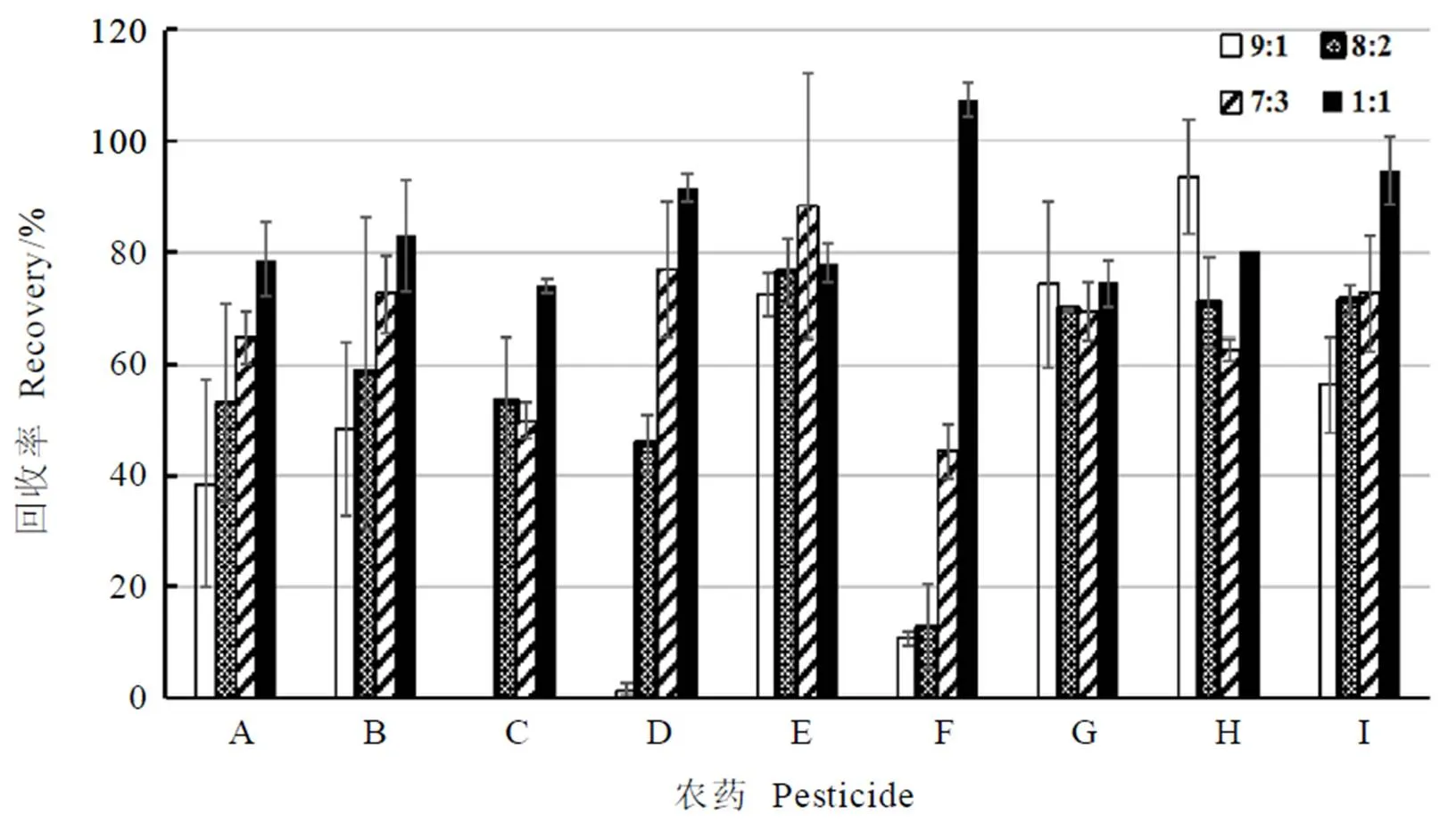
注:A:甲氧蟲酰肼;B:魚藤酮;C:嘧菌酯;D:苯醚甲環唑;E:茚蟲威;F:氟定蟲酰胺;G:吡唑嘧菌酯;H:聯苯菊酯;I:蟲螨腈。下同
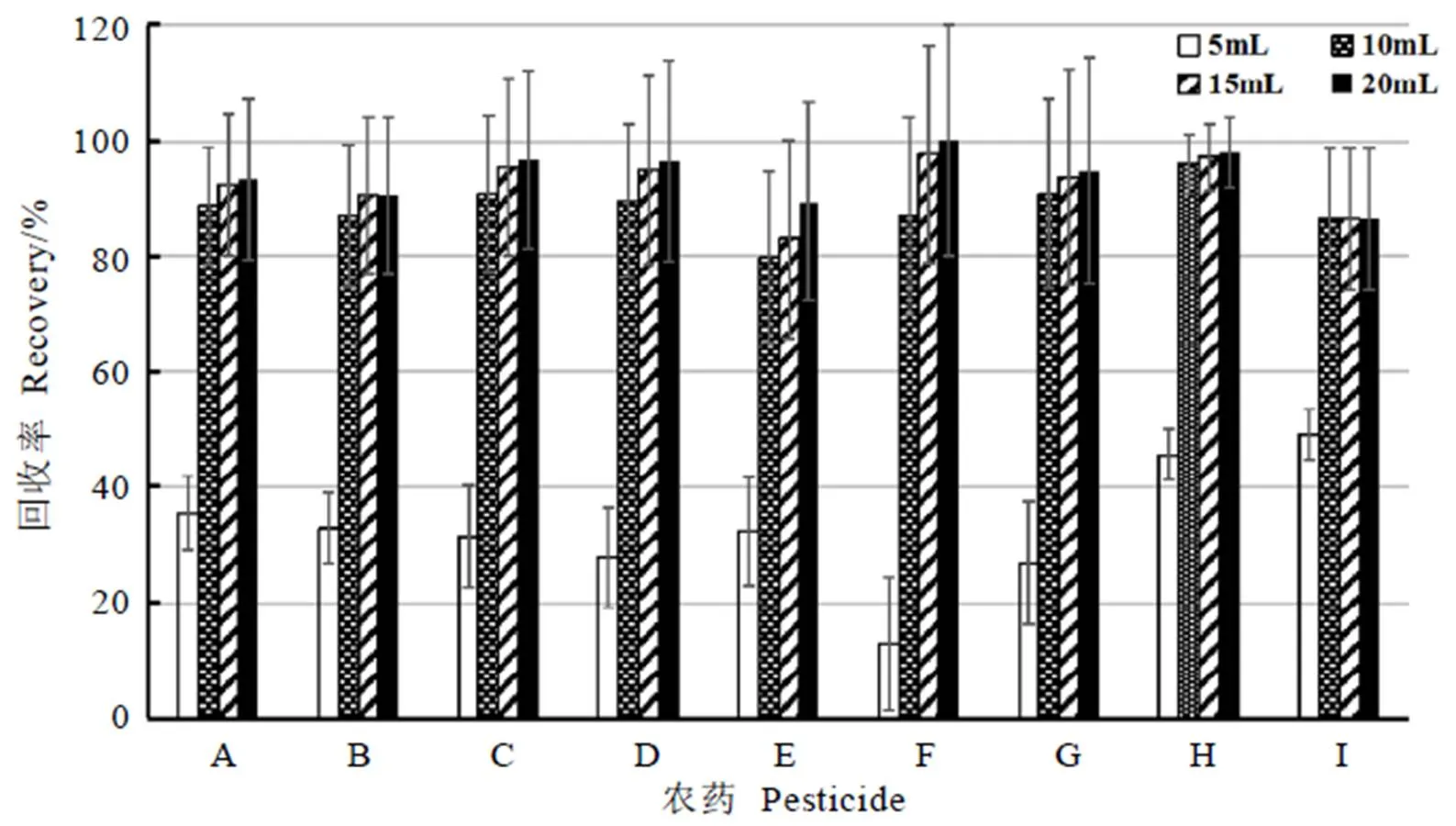
圖2 Florisil+GCB混合柱的洗脫溶劑體積對農藥回收率的影響
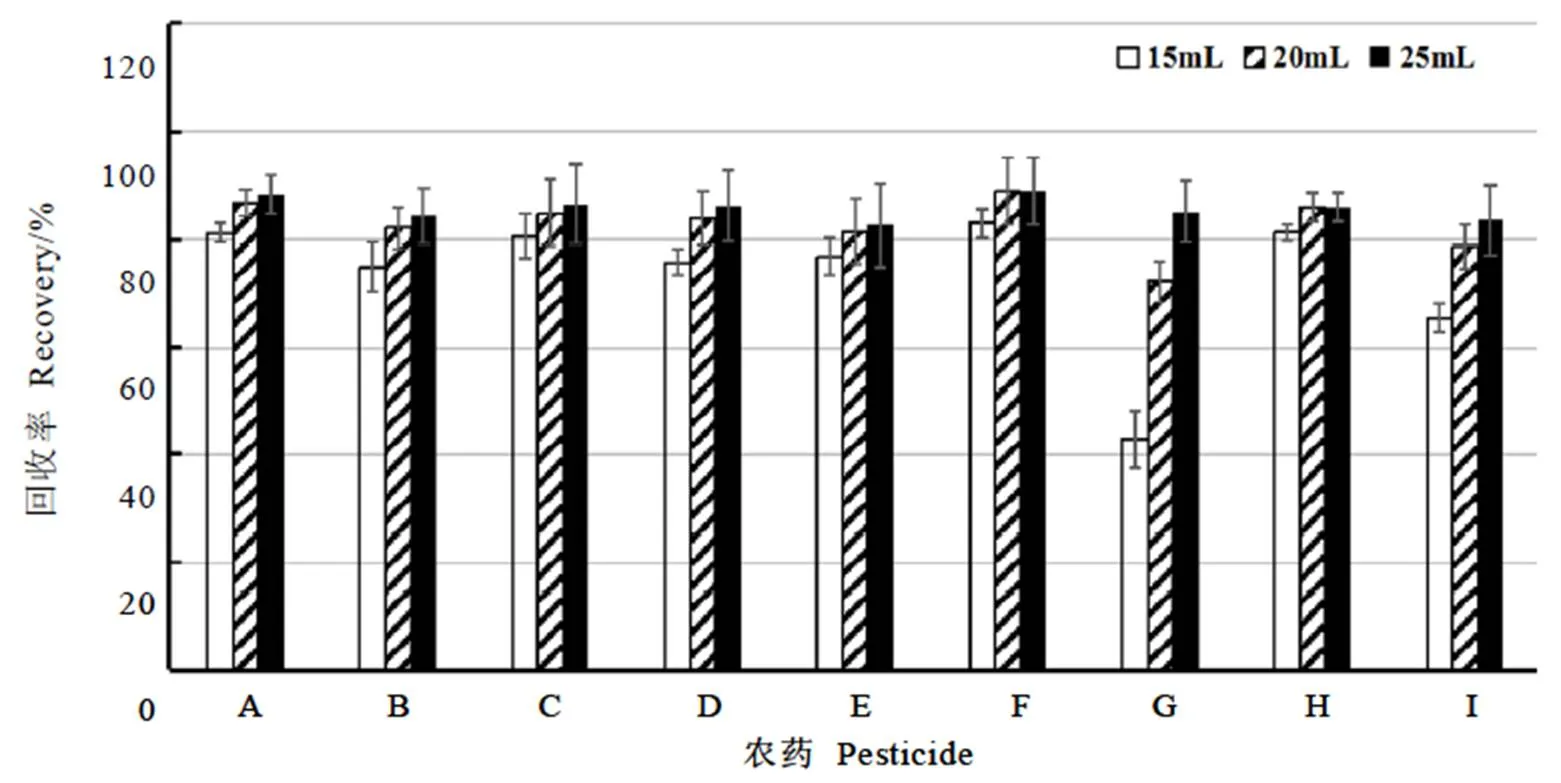
圖3 TPT柱的洗脫溶劑體積對農藥回收率的影響
2.2 線性方程和基質效應
制備鮮葉和干茶的基質空白溶液,并用空白基質溶液配置質量濃度為2.00、1.00、0.50、0.20、0.05、0.005?mg·L-1的基質匹配標準溶液。
以溶劑標準溶液與鮮葉和干茶的基質匹配標準溶液的斜率計算基質效應[32]:
=(K-K)/K×100%
其中K為基質標準曲線的斜率,K為溶劑標準曲線的斜率。結果如表4所示,在0.005~2?mg·kg-1的濃度范圍內,目標化合物在溶劑、鮮葉基質和干茶基質中的線性關系良好,線性相關系數在0.995?4~0.999?8。
鮮葉中9種農藥的基質效應在–29.3%~23.7%,其中除氟啶蟲酰胺(–29.3%)和聯苯菊酯(23.7%)的基質效應高于20%外,其他7種農藥在茶鮮葉基質中的基質效應不顯著。干茶中9種農藥的基質效應明顯高于鮮葉中,除了蟲螨腈在干茶中的基質效應小于鮮葉中外,其他8種農藥干茶中的基質效應明顯高于鮮葉中,范圍在–77.8%~58.9%,干茶基質引起的基質增強或基質減弱效應明顯。因此,茶葉中目標化合物定量均采用基質匹配標準溶液。
2.3 回收率和精密度
鮮葉和干茶基質中9種農藥的添加回收率和精密度見表5。在0.005~1.000?mg·kg-1的添加范圍內,目標化合物的回收率范圍在70.3%~103.9%,RSD<20.0%。LOQ以最小添加濃度表示,為0.005?mg·kg-1。
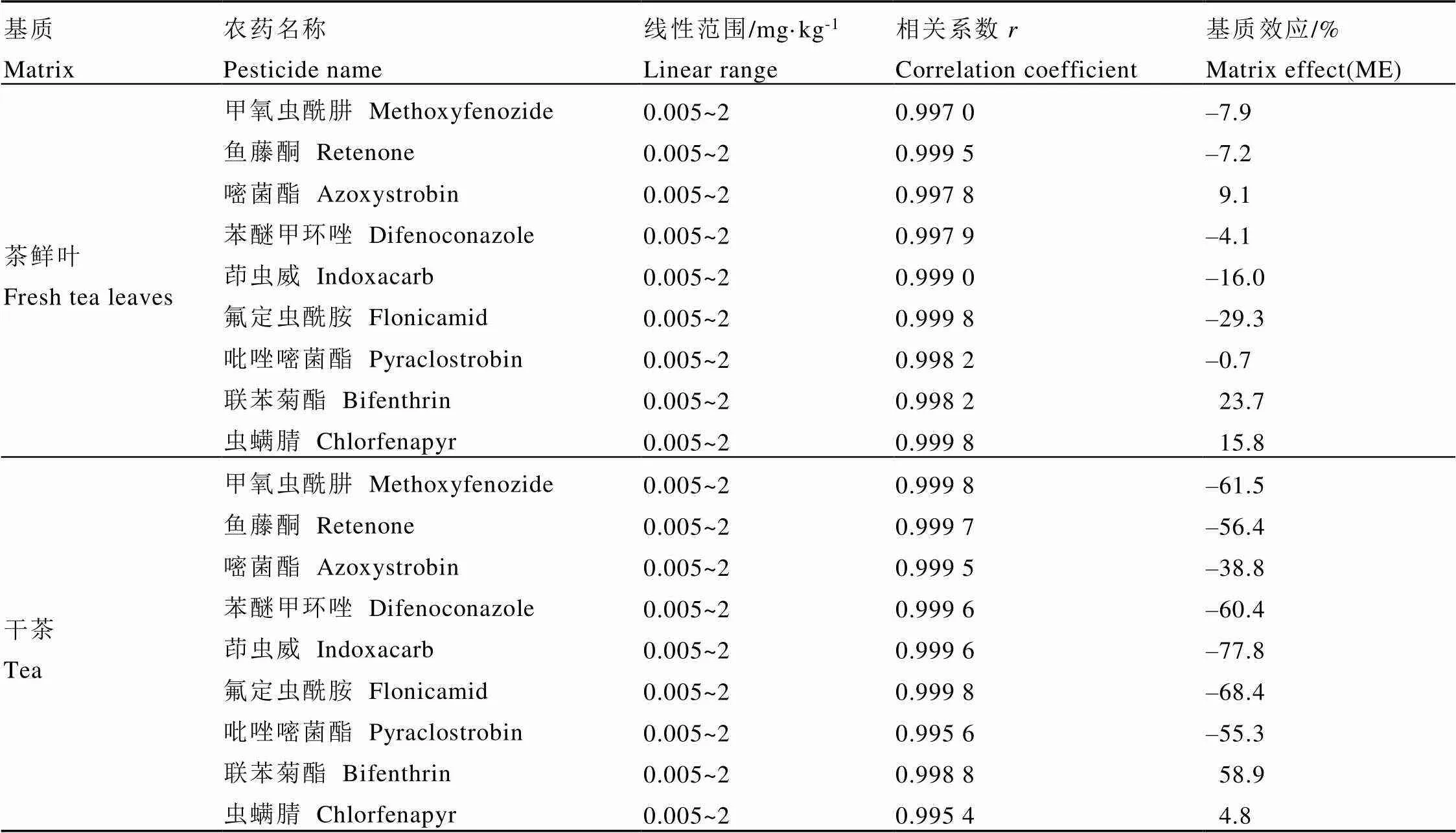
表4 農藥的線性方程和相關系數

表5 農藥的添加回收率和LOQ(n=5)
2.4 實際樣品測定
采用本文方法測定了市售27份茶葉樣品,其中2份檢出茚蟲威(0.007~0.008?mg·kg-1)、14份檢出聯苯菊酯(0.006~0.400?mg·kg-1),2份檢出蟲螨腈(0.005~0.200?mg·kg-1),8份檢出苯醚甲環唑(0.008~0.300?mg·kg-1),7份檢出吡唑嘧菌酯(0.005~0.030?mg·kg-1),檢出樣品的農藥殘留量均遠低于我國GB/T 2763—2019[33]中規定的相關農藥的最大殘留限量水平(茚蟲威5?mg·kg-1,聯苯菊酯5?mg·kg-1,蟲螨腈20?mg·kg-1,苯醚甲環唑10?mg·kg-1,吡唑醚菌酯10?mg·kg-1)。所有茶樣均未檢出甲氧蟲酰肼、嘧菌酯、魚藤酮和氟定蟲酰胺。
3 結論
本研究通過優化茶鮮葉和干茶基質中目標農藥的前處理條件,比較4種方法對茶葉中目標物質回收率、基質效應、溶劑使用量和試驗時間成本的差異,建立了乙腈提取,Florisil+GCB混合柱和PSA/GCB分散固相聯合凈化,UPLC-MS/MS和GC-MS測定茶葉中氟啶蟲酰胺等9種農藥的低成本測定方法。對市售27份茶葉樣品的篩查結果表明,該方法適用于茶葉中目標農藥殘留的定量分析檢測。
[1] 李加成. 我國農業病蟲害防治現狀及建議分析[J]. 種子科技, 2017, 35(6): 106-108. Li J C. Status analysis and suggestions of the disease and pest control in China [J]. Seed Science & Technology, 2017, 35(6): 106-108.
[2] 羅宗秀, 蘇亮, 陳宗懋. 茶園農藥須注意更新換代[J]. 中國茶葉, 2018, 40(3): 36-38. Luo Z X, Su L, Chen Z M. Attention should be paid to update the pesticide in tea garden [J]. China Tea, 2018, 40(3): 36-38.
[3] 田新湖, 陳益生. 魚藤酮等生物農藥防治茶假眼小綠葉蟬藥效試驗[J]. 上海農業科技, 2012, 28(1): 127-130. Tian X H, Chen Y S. Control efficacy of rotenone and other biological pesticides on the tea green leafhopper [J]. Shanghai Agricultural Science and Technology, 2012, 28(1): 127-130.
[4] 趙豐華, 任紅樓, 蔣雙豐, 等. 豫南茶園主要害蟲防治藥劑篩選研究[J]. 天津農業科學, 2014, 20(12): 94-98. Zhao F H, Ren H L, Jiang S F, et al. Screening of main pests insecticides in South Henan tea garden [J]. Tianjin Agricultural Sciences, 2014, 20(12): 94-98.
[5] 盧兆成, 趙海英, 喬利. 13種殺蟲劑防治茶尺蠖室內藥效試驗[J]. 農藥科學與管理, 2012, 33(6): 46-50. Lu Z C, Zhao H Y, Qiao L. The laboratory test of thirteen in secticides againstWehrli [J]. Pesticide Science and Administration, 2012, 33(6): 46-50.
[6] 趙曉珍, 段長流, 李冬雪, 等. 茶葉斑點病的藥劑篩選及田間防治技術初步研究[C]//中國植物保護學會. 綠色生態可持續發展與植物保護——中國植物保護學會第十二次全國會員代表大會暨學術年會論文集. 北京: 2017. Zhao X Z, Duan C L, Li D X, et al. Preliminary research on chemicals screening and field control of tea spot disease [C]//Chinese Society of Plant Protection. Sustainable Development of Green Ecology and Plant Protection: Proceedings of the 12th National Congress of the Chinese Society of Plant Protection. Beijing: 2017.
[7] 周曉東, 王潤龍, 黃亞輝, 等. 天王星(聯苯菊酯)在茶葉生產上的安全性試驗[J]. 茶葉通訊, 2002(3): 24-25. Zhou X D, Wang R L, Huang Y H, et al. Safety test of uranus (bifenthrin) in tea production [J]. Journal of Tea Communication, 2002(3): 24-25.
[8] 張新忠, 羅逢健, 陳宗懋, 等. 分散固相萃取凈化超高效液相色譜串聯質譜法研究茶葉與茶湯中茚蟲威殘留降解規律[J]. 分析測試學報, 2013, 32(1): 1-8. Zhang X Z, Luo F J, Chen Z M, et al. Study of indoxacarb residue degradation in tea and tea Infusion by ultra high performance liquid chromatography coupled with tandem mass spectrometry after dispersive solid phase extraction cleanup [J]. Journal of Instrumental Analysis, 2013, 32(1): 1-8.
[9] 錢承敬, 史曉梅, 謝云峰, 等. 氣相色譜-串聯質譜法測定茶葉茶湯中多種農藥殘留量[J].食品安全質量檢測學報, 2017, 8(8): 3218-3230. Qian C J, Shi X M, Xie Y F, et al. Determination of multi-pesticide residue in tea and tea infusion by gas chromatography-tandem mass spectrometry [J]. Journal of Food Safety & Quality, 2017, 8(8): 3218-3230.
[10] Wu C. Multiresidue method for the determination of pesticides in Oolong tea using QuEChERS by gas chromatography-triple quadrupole tandem mass spectrometry [J]. Food Chemistry, 2017, 229: 580-587.
[11] 王兵, 李斌, 張媛媛, 等. QuEChERS-高效液相色譜法測定綠茶中蟲螨腈殘留[J]. 中國食品學報, 2017, 17(1): 240-245. Wang B, Li B, Zhang Y Y, et al. Determination of chlorfenapyr in green tea by QuEChERS-high-performance liquid chromatography [J]. Journal of Chinese Institute of Food Science and Technology, 2017, 17(1): 240-245.
[12] 李瑋, 賈彥博, 林偉杰, 等. 分散固相萃取凈化-氣相色譜-質譜聯用法測定茶葉中7種殺螨殺蟲類農藥殘留[J]. 食品安全質量檢測學報, 2017, 8(9): 3485-3490. Li W, Jia Y B, Lin W J, et al. Determination of 7 pesticides residues in tea by gas chromatography-mass spectrometry combined with dispersive solid phase extration [J]. Journal of Food Safety & Quality, 2017, 8(9): 3485-3490.
[13] Zhang X Z, Luo F J, Lou Z Y, et al. Simultaneous and enantioselective determination of-epoxiconazole and indoxacarb residues in various teas, tea infusion and soil samples by chiral high performance liquid chromatography coupled with tandem quadrupole-time-of-flight mass spectrometry [J]. Journal of Chromatography A, 2014, 1359: 212-223.
[14] 吳林, 吳曉波, 張承聰, 等. 固相萃取-氣相色譜法同時檢測茶葉中多種農藥和多氯聯苯殘留[J]. 食品科學, 2011, 32(14): 223-226. Wu L, Wu X B, Zhang C C, et al. Multiresidue determination of pesticides and polychlorinated biphenyls in tea by solid-phase extraction and gas chromatography [J]. Food Science, 2011, 32(14): 223-226.
[15] Song W H, Xie L P, Shao T F. Determination of 33 pesticides in tea by accelerated solvent extraction-gel permeation and solid-phase extraction purification-gas chromatography-mass spectrometry [J]. Chinese Journal of Chromatography, 2008, 26(1): 22-28.
[16] 徐敦明, 盧聲宇, 陳達捷, 等. 加速溶劑萃取-氣相色譜-串聯質譜法測定茶葉中10種吡唑和吡咯類農藥的殘留量[J]. 色譜, 2013, 31(3): 218-222. Xu D M, Lu S Y, Chen D J, et al. Determination of ten pesticides pyrazoles and pyrroles in tea by accelerated solvent extraction coupled with gas chromatography-tandem mass spectrometry [J]. Chinese Journal of Chromatography, 2013, 31(3): 218-222.
[17] 李軍明, 鐘讀波, 王亞琴, 等. 在線凝膠滲透色譜-氣相色譜/質譜法檢測茶葉中的153種農藥殘留[J]. 色譜, 2010, 28(9): 840-848. Li J M, Zhong D B, Wang Y Q, et al. Determination of 153 pesticides in tea using online gelpermeation chromatography-gas chromatography/mass spectrometry [J]. Chinese Journal of Chromatography, 2010, 28(9): 840-848.
[18] 唐吉旺, 王建秀, 袁列江, 等. 氣相色譜-串聯質譜法測定茶葉中24種農藥殘留量[J]. 理化檢驗(化學分冊), 2015, 51(11): 1557-1561. Tang J W, Wang J X, Yuan L J, et al. GC-MS/MS determination of residual amounts of 24 pesticides in tea [J]. Physical Testing and Chemical Analysis (Part B: Chemical Analysis), 2015, 51(11): 1557-1561.
[19] 周華, 張蘊, 吳平谷, 等. 固相萃取-氣相色譜質譜聯用法測定茶葉中溴蟲腈和茚蟲威[J]. 衛生研究, 2016, 45(5): 817-820. Zhou H , Zhang Y , Wu P G, et alDetermination of chlorfenapyr and indoxacarb in tea by gas chromatography-mass spectrometry with solid phase extraction [J]. Journal of Hygiene Research, 2016, 45(5): 817-820.
[20] 許欣欣, 王冰, 陳慧玲, 等. 氣相色譜-質譜聯用法測定茶葉中溴蟲腈、啶蟲脒和茚蟲威[J]. 預防醫學情報雜志, 2017, 33(9): 901-904. Xu X X, Wang B, Chen H L, et al. Determination of chlorfenapyr, acetamiprid and indoxacarb in tea by gas chromatography/mass spectrometry [J]. Journal of Preventive Medicine Information, 2017, 33(9): 901-904.
[21] 姚銘棟. 固相萃取-氣相色譜/串聯質譜法測定茶葉中49種農藥殘留量[J]. 中國衛生檢驗雜志, 2014, 24(15): 2170-2173. Yao M D. Determination of 49 pesticides in tea by solid phase extraction-gas chromatography/tandem mass spectrometry [J]. Chinese Journal of Health Laboratory Technology, 2014, 24(15): 2170-2173.
[22] 王興寧, 蔡秋, 朱明, 等. 固相萃取凈化-氣相色譜/串聯質譜法測定茶葉中54種農藥殘留量[J]. 分析試驗室, 2011, 30(11): 110-116. Wang X N, Cai Q, Zhu M, et al. Determination of 49 pesticide residues in tea using solid-phase extraction and gas chromatography-triple quadrupole mass spectrometry [J]. Chinese Journal of Analysis Laboratory, 2011, 30(11): 110-116.
[23] Tewary D K, Kumar V, Ravindranath S D, et alDissipation behavior of bifenthrin residues in tea and its brew [J]. Food Control, 2005, 16(3): 231-237.
[24] Hou X, Lei S, Guo L, et al. Optimization of a multi-residue method for 101 pesticides in green tea leaves using gas chromatography-tandem mass spectrometry [J]. Revista Brasileira de Farmacognosia, 2016; 26(4): 401-407.
[25] Rajski ?, Lozano A, Belmonte-Valles N, et al. Comparison of three multiresidue methods to analyse pesticides in green tea with liquid and gas chromatography/tandem mass spectrometry [J]. Analyst, 2013, 138(3): 921-931.
[26] Peng C F, Kuang H, Li X Q, et al. Evaluation and interlaboratory validation of a GC-MS method for analysis of pesticide residues in teas [J]. Chemical Papers, 2007, 61(1): 1-5.
[27] European Communities. Commission Decision 2002/657/EC of 12 August 2002 implementing Council Directive 96/23/EC concerning the performance of analytical methods and the interpretation of results [S]. Official Journal of the European Communities, 2002: 8-36.
[28] 全國認證認可標準化技術委員會實驗室認可分技術委員會. 合格評定化學分析方法確認和驗證指南: GB/T 27417—2017[S]. 北京: 中國標準出版社, 2017. Subcommittee 1 on Laboratory Accreditation of National Technical Committee 261 on Certification and Accreditation of Standardization Administration of China. Comformity assessment—Guidance on validation and verification of chemical analytical methods: GB/T 27417—2017 [S]. Beijing: Standards Press of China, 2017.
[29] 張新忠, 羅逢健, 陳宗懋, 等. 超高效液相色譜串聯質譜法測定茶葉、茶湯和土壤中氟環唑、茚蟲威和苯醚甲環唑殘留[J]. 分析化學, 2013, 41(2): 215-222. Zhang X Z, Luo F J, Chen Z M, et al. Residue determination of epoxiconazole, indoxacarb and difenoconazole in tea, tea infusion and soil using ultra high performance liquid chromatography coupled with tandem mass spectrometry [J]. Chinese Journal of Analytical Chemistry, 2013, 41(2): 215-222.
[30] Chen G, Cao P, Liu R. A multi-residue method for fast determination of pesticides in tea by ultra performance liquid chromatography-electrospray tandem mass spectrometry combined with modified QuEChERS sample preparation procedure [J]. Food Chemistry, 2011, 125(4): 1406-1411.
[31] Díez C, Traag W A, Zommer P, et al. Comparison of an acetonitrile extraction/partitioning and “dispersive solid-phase extraction” method with classical multi-residue methods for the extraction of herbicide residues in barley samples [J]. Journal of Chromatography A, 2006, 1131(1/2): 11-23.
[32] Besil N, Cesio V, Heinzen H, et al. Matrix effects and interferences of different citrus fruits coextractives in pesticide residue analysis using ultra high-performance liquid chromatography—high-resolution mass spectrometry [J]. Journal of Agricultural and Food Chemistry, 2017: 65(23): 4819-4829.
[33] 中華人民共和國國家衛生健康委員會. 食品安全國家標準食品中農藥最大殘留限量: GB 2763—2019[S]. 北京: 中國農業出版社, 2019. National Health Commission of the People's Republic of China. National food safety standard—Maximum residue limits for pesticides in food: GB 2763—2019 [S]. Beijing: China Agriculture Press, 2019.
Determination of Pesticide Residue in Fresh Tea Leaves and Dry Tea by Solid Extraction and Dispersive Solid Extraction Cleanup Coupled with Tandem Mass Spectrum
YANG Jie1,2, ZHOU Li1*, YU Huan1,2, SUN Hezhi1, WANG Xinru1, ZHANG Xinzhong1, YANG Mei1, CHEN Zongmao1, LUO Fengjian1*
1. Research Center of Quality Safety for Agricultural Products, Tea Research Institute, Chinese Academy of Agricultural Sciences Hangzhou 310008, China; 2. Graduate School of Chinese Academy of Agricultural Sciences, Beijing 100081, China
A method for the determination of 9 pesticide residues in fresh and dry tea was established. Residual pesticides in samples were extracted by acetonitrile, purified by Florisil/GCB solid phase extraction column, followed by absorbent of PSA and GCB as dispersed solid phase, and determined by ultra-high performance liquid chromatography-tandem mass spectrometry (UPLC-MS/MS) and gas chromatography-mass spectrometry (GC-MS). In the spiked range of 0.005-1.000?mg·kg-1, the average recoveries of target pesticides in fresh leaves and dried tea were 70.3%-103.9%, and the relative standard deviations (RSD) were less than 20%. In the range of 0.005-2.000?mg·kg-1, the linear relationship of target pesticides in fresh leaves and dry tea matrix was good, with>0.995?4. The limit of quantity (LOQ) was 0.005?mg·kg-1. The test results of actual samples showed that the method was highly sensitive and reproducible, and can meet the requirements of multi-residue detection.
multi-residue of pesticides, UPLC-MS/MS, GC-MS, tea, solid phase extraction, dispersive solid-phase extraction
世界首個“國際茶日”
2020年5月21日,是聯合國確定的首個“國際茶日”。國家主席習近平向“國際茶日”系列活動致信表示熱烈祝賀。
習近平指出,茶起源于中國,盛行于世界。聯合國設立“國際茶日”,體現了國際社會對茶葉價值的認可與重視,對振興茶產業、弘揚茶文化很有意義。作為茶葉生產和消費大國,中國愿同各方一道,推動全球茶產業持續健康發展,深化茶文化交融互鑒,讓更多的人知茶、愛茶,共品茶香茶韻,共享美好生活。
茶是世界三大飲品之一,全球產茶國和地區達60多個,飲茶人口超過20億。2019年12月,聯合國大會宣布將每年5月21日確定為“國際茶日”,以贊美茶葉的經濟、社會和文化價值,促進全球農業的可持續發展。今年“國際茶日”期間,我國農業農村部與聯合國糧農組織、浙江省政府以“茶和世界共品共享”為主題,通過網絡開展系列宣傳推廣活動。
5月21日下午,中國茶葉學會在線舉辦了“美美與共”云茶會。云茶會邀請了廣大民眾在同一時間一同飲茶,多地聯動,打破時間和空間束縛,以“名家、名茶、名匠、民族”為核心展示內容。旨在分享茶健康知識,彰顯制茶人匠心,展示茶民俗文化,提振疫情后產業信心,推廣貧困地區茶品牌,帶動茶農增收致富,體現我國茶業總體風貌,促進中國與世界各國茶文化交融互鑒和全球農業可持續發展。
S571.1;S482
A
1000-369X(2020)03-397-10
2019-09-27
2020-01-04
國家重點研發計劃子課題(2016YFD0200207-2)、浙江省自然科學基金(LY18C16005)
楊潔,女,碩士研究生,主要從事茶園有害生物綜合治理研究。*通信作者:lizhou@tricaas.com,lfj@tricaas.com
投稿平臺:http://cykk.cbpt.cnki.net

